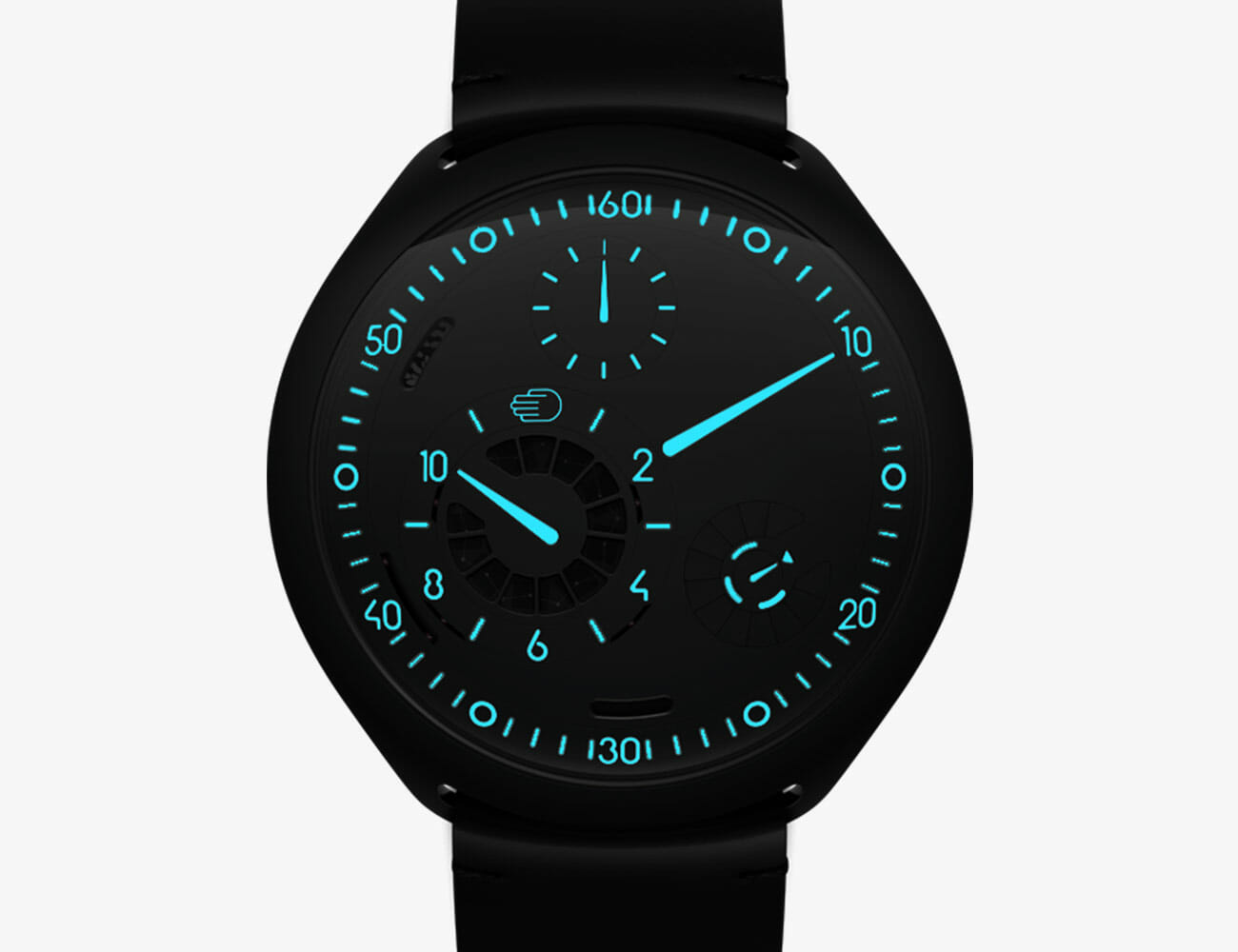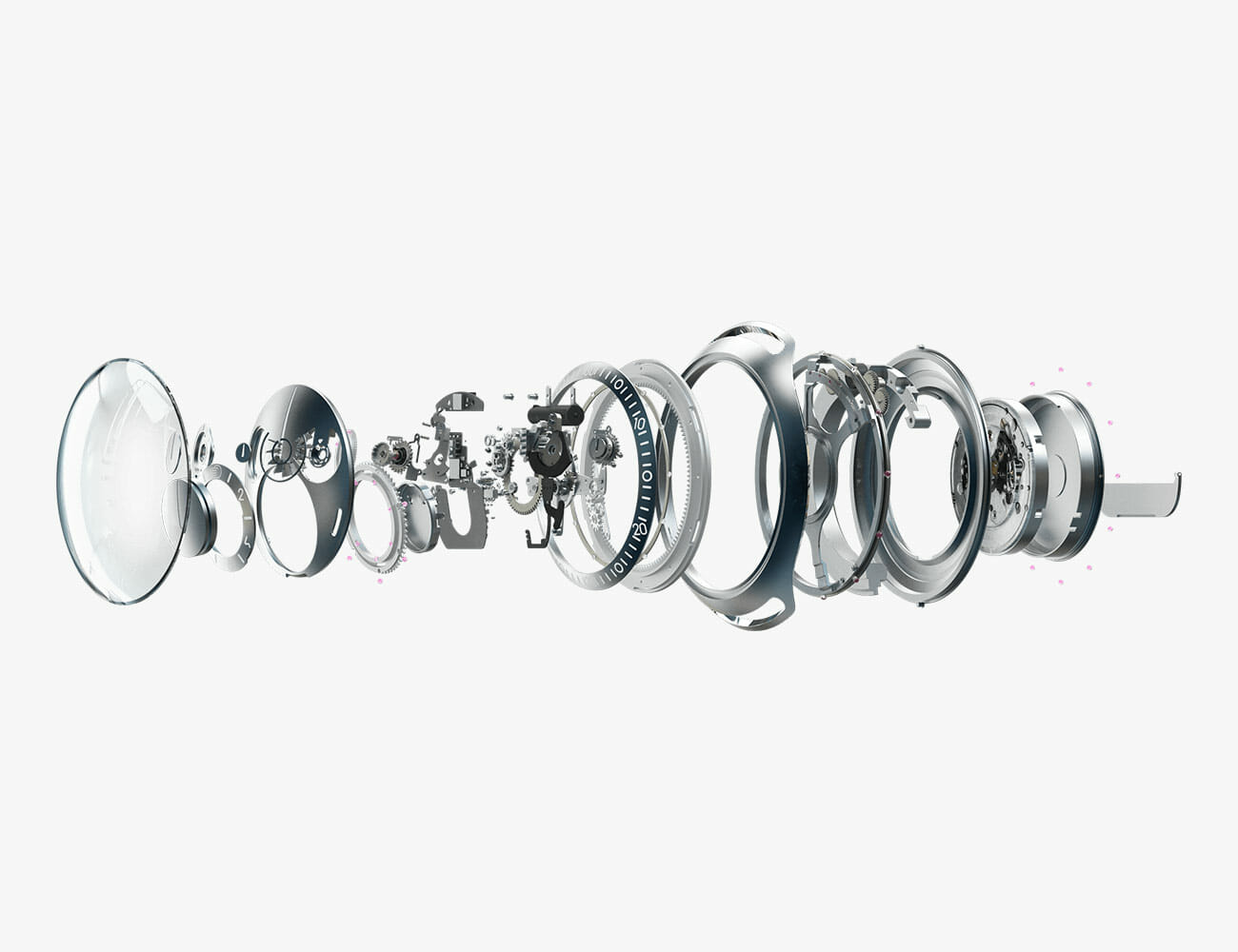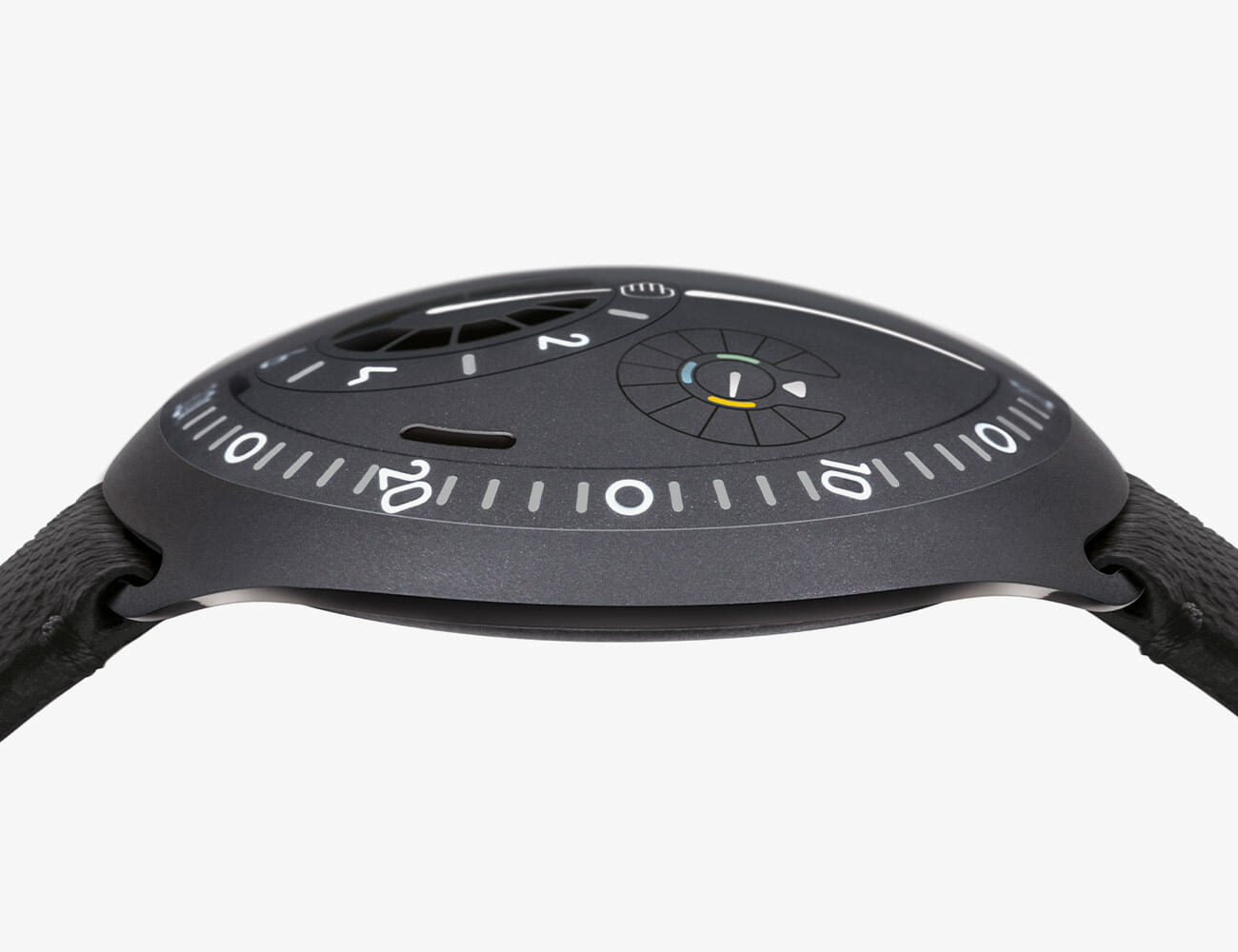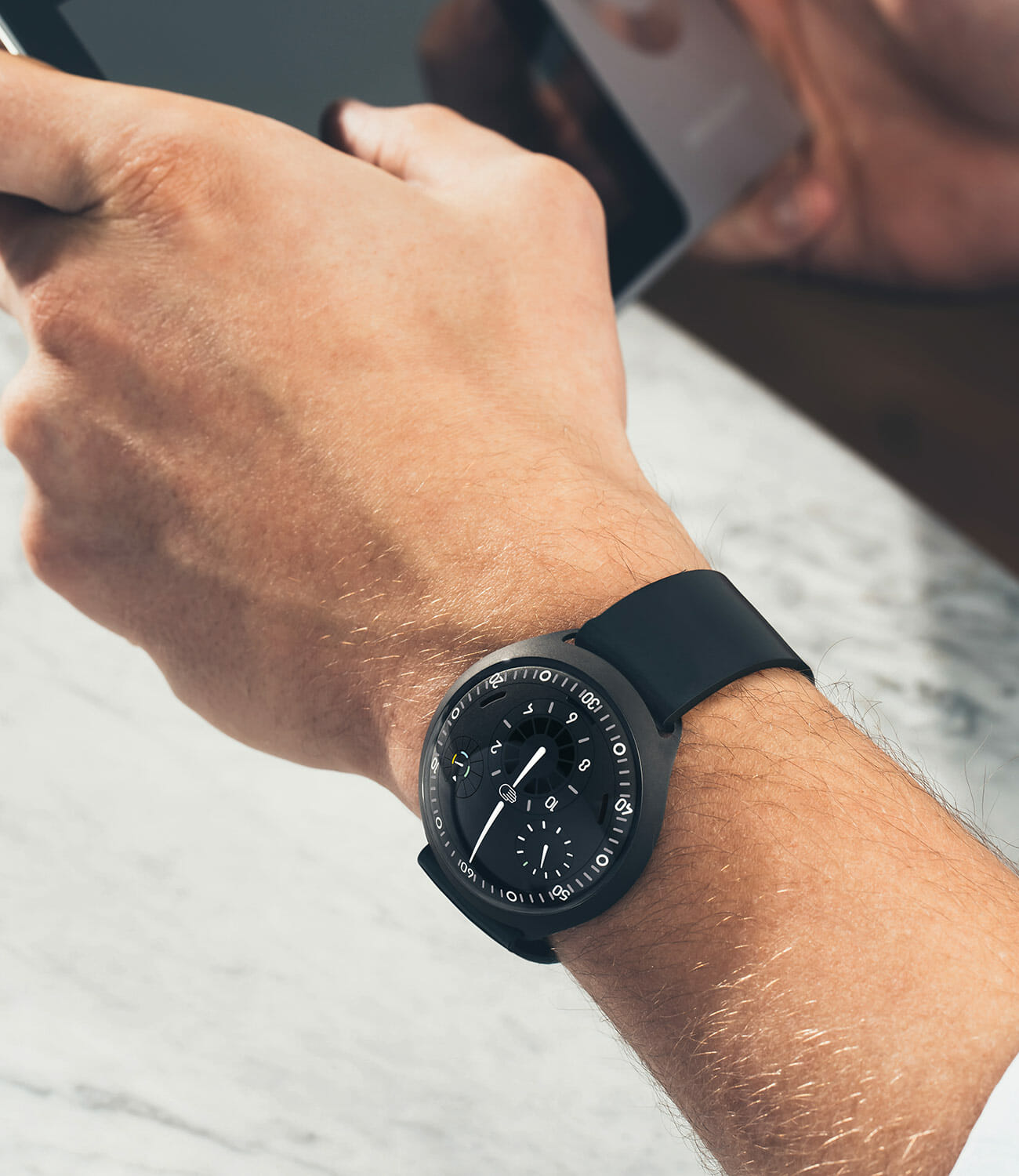“The concept behind it is improving on the mechanical watch, not building another Fitbit,” independent watchmaker Ressence’s CEO Benoît Mintiens explains as he taps the domed glass of his most ambitious product yet, the Type 2 e-Crown, to “wake it up.” The entire dial along with inner-mounted discs shimmy and glide in a coordinated movement that’s incomparable to that of any other watch, the hands robotically taking their time-telling positions.
Up Close with the Ressence Type 2 e-Crown
For more video news and reviews subscribe to the Gear Patrol YouTube channel here.
Combining mechanical watchmaking and cutting-edge digital tech, the Type 2 e-Crown has been called possibly the most significant change in timekeeping in the past century. Though Ressence’s approach is certainly innovative, it will take some effort for many consumers to wrap their minds around what is essentially a new product category, and several key questions first warrant explaining: How does the technology work? Who is this type of watch for?
Coming from an industrial design background, Mr. Mintiens likes to think in terms of “added value in the relationship you create with the product.” Like Ressence’s other watches, the Type 2 e-Crown uses an automatic mechanical movement — that is, it’s powered by the tension of a slowly unwinding spring kept continually wound by the motion of the wearer’s wrist. However, on top of this traditional movement is an electronic module, battery-powered and solar-charged, called the e-Crown, which provides various optional but “value-adding” functions.
Ressence envisions a watch-wearing experience made totally hassle-free — setting the time, switching between time zones, keeping the watch wound, and ensuring it’s accurate are all ways the e-Crown is meant to improve user experience. Those who are familiar with mechanical watches will appreciate these touches most, and they are the brand’s target audience.

To be more specific: connected via bluetooth to a smartphone, you can use the Ressence app to select and set two time zones, and the module in the watch will remember them without the need to be connected to the phone. You can switch between these two time zones by tapping on the glass, which is convenient, but the e-Crown is also doing a lot more that doesn’t require the user’s direct attention. It’s these little touches and how cleverly it’s all integrated with a mechanical movement that makes the Type 2 e-Crown so remarkable. The reliability of electronics and computer technology provides that extra little element of “trust” that’s lacking from traditional mechanical watches, according to Mr. Mintiens.
“It’s not normal that you should buy a very expensive watch and yet you check your phone to make sure it’s on time.”
“With mechanical watches, we don’t trust them 100%. We trust them 99%. And it’s like your ‘70s car without electronic injection: it’s with a carburetor, and it’s really nice, and I really love it… but when I need to catch a plane I want to take a car that I’m 100% sure will start.”
Of course, one can opt to enjoy the Ressence Type 2 e-Crown simply as a mechanical watch and never make use its extended features (though this would essentially be the experience Ressence offers in its non-e-Crown-equipped watches). The e-Crown’s features are available when you need them, made to enhance the wearing experience, rather than function as a collection of smartwatch features that you don’t necessarily want. If you’d like phone notifications and fitness tracking, there are plenty of watches without mechanical movements that don’t cost the Type 2’s nearly $50,000. Though other watchmakers have tried to offer both experiences at once, Ressence is the first to create a watch where the mechanical movement is actually integrated with electronics — and it took three years of development, working with “father of the iPod,” Tony Fadell, to perfect.

You could compare the Ressence Type 2 e-Crown to a cyborg. The mechanical and electronic components are like separate organisms with independent power sources, but they work together. When the electronics’ batteries deplete down to 50%, small shutters open in the dial to let light reach integrated solar cells and recharge them. The user can also open the shutters via the app. The mechanical movement’s mainspring is wound automatically when the watch is worn via a traditional rotor — and the case back acts like a traditional crown for manually winding or setting the watch.
The interaction, however, is where the added value is — and where the concept becomes truly clever. If the e-Crown detects that the watch has been unworn for 12 hours, it will stop the automatic movement to save the mainspring’s power reserve. When it’s picked up again, not only will the movement restart, but the correct current time stored in the electronics will set the hands directly to that time. Anyone who has lived with a mechanical watch and has had to set one following a period of disuse will appreciate the value this offers. It’s a small convenience, sure, but the solution shows a great amount of care and thoughtful engineering, and a watchmaker’s approach.
The presence of an accelerometer is how the e-Crown knows when it’s being worn. It registers the acceleration of gravity, and is how smartphones (and other gadgets) detect directions, tilts, vibrations, and count your steps. In the Ressence Type 2, it’s also how the taps are registered on the crystal. (Tapping on the crystal is how one switches between functions and time zones.)

The e-Crown syncs with a smartphone via Bluetooth, but it stores data itself and doesn’t rely on a phone’s constant connection to offer its functionality. Time zones can be set manually by the user if desired, but setting them via the Ressence app means they receive the accurate time via your phone, and this time signal remains stored in the watch. So, even though, as Benoît Mintiens points out, “your mechanical watch is more than precise enough for your daily needs,” the electronics can update the mechanically driven watch with hyper-accurate current time. “It’s not normal that you should buy, let’s say, a $25,000 watch and that you check your phone to make sure it’s on time,” he convincingly asserts.
“The emotional connection you can have to a mechanical watch is a lot stronger than with a digital one. But the electronics give you the extra sense of trust.”
Ressence’s e-Crown tech is unique, though not the sole example of hybrid technology in the watchmaking landscape. Seiko’s Spring Drive is another well known example that uses the mainspring of a traditional mechanical movement for power, but regulates timekeeping with electricity and a quartz crystal. Frederique Constant’s Hybrid Manufacture watch features an in-house mechanical movement that incorporates a connected module to offer “smart” features — but its electronics aren’t directly integrated with the mechanical components the way the e-Crown is integrated into the Type 2’s movement.
Frederique Constant does provide analytics about its hybrid watches’ mechanical movements to the user, and another high-end brand, Urwerk, has offered something similar. The Ressence e-Crown collects analytics about the movement’s health, but rather than making it visible to users, it goes to a server’s back end so that Ressence can notify clients when their watch might need service. Offering this data directly to the user seems like something that customers might appreciate and a potential improvement to add in a future e-Crown “2.0” release.

Ressence was an unconventional and forward-thinking brand even before the e-Crown’s introduction. Like other Ressence watches, the Type 2 uses the brand’s in-house “orbital convex system,” which creates a unique visual effect — the dial not only follows the curve of the crystal, but moves in the unique, coordinated way you can see in the video above. Simply tapping the dial to see the entire dial move is a delight on any Ressence watch — and the e-Crown allows you to play with it, show your friends, and then simply tap to return to the correct time.
Ressence aims to offer the experience of a high-end mechanical watch, augmented by the benefits digital technology can offer to it. At $48,800, the Type 2 is still a niche product that only wealthy clientele can afford, but one that paves a new way for the mechanical watch industry as the world around it increasingly adopts smartwatches. “It’s the relationship between you and the product that we want to improve,” Mitiens says. “The emotional connection you can have to a mechanical watch is a lot stronger than with a digital one. That is why we do mechanical watches. But the electronics give you the extra sense of trust.”

